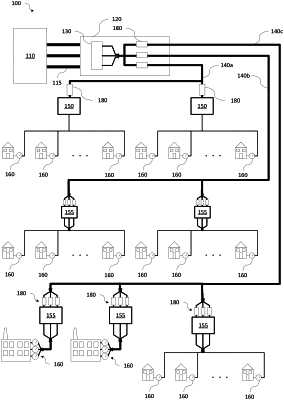| CPC H02J 3/12 (2013.01) [G05B 13/0265 (2013.01); H02J 13/00002 (2020.01)] | 14 Claims |

|
1. A method comprising:
receiving, by a headend system, descriptors from a plurality of utility devices connected to a resource distribution system, the descriptors being generated at the respective utility devices by processing sensor data obtained at the respective utility devices;
determining that the descriptors contain synchronizing events;
adjusting timing of other events in the descriptors using a time of occurrence of the synchronizing events as a reference time;
determining, based on the synchronizing events, time offsets for one or more of the plurality of utility devices;
transmitting instructions to the one or more of the plurality of utility devices to correct clocks according to the respective time offsets;
determining a mode of the plurality of utilize devices;
in response to determining that the mode of the plurality of utility devices is a regular mode,
grouping, by the headend system, the plurality of utility devices to generate a current grouping by applying clustering algorithms to the descriptors of the plurality of utility devices, and
assigning, by the headend system, at least one of a segment identifier or a phase identifier to one or more of the plurality of utility devices based, at least in part, upon the current grouping;
in response to determining that the mode of the plurality of utility devices is a fast mode, wherein in the fast mode, the segment identifier or the phase identifier is assigned to a utility device in a shorter time period than the regular mode,
grouping the plurality of utility devices by correlating the descriptors;
generating assignment information by assigning at least one of a segment identifier or a phase identifier to an unknown utility device among the plurality of utility devices based on the grouping; and
sending the assignment information to the unknown utility device.
|